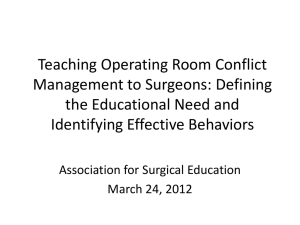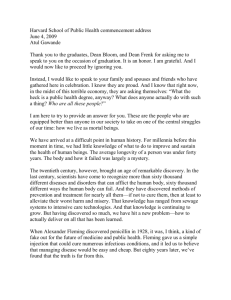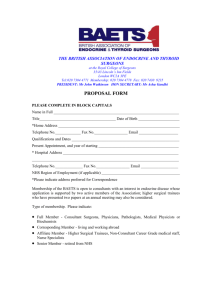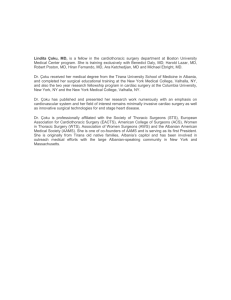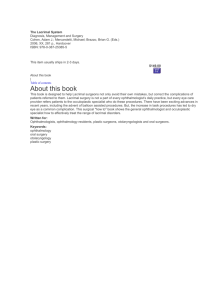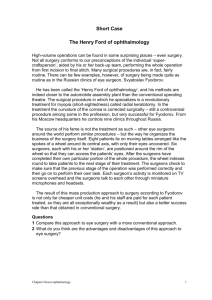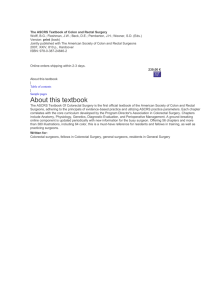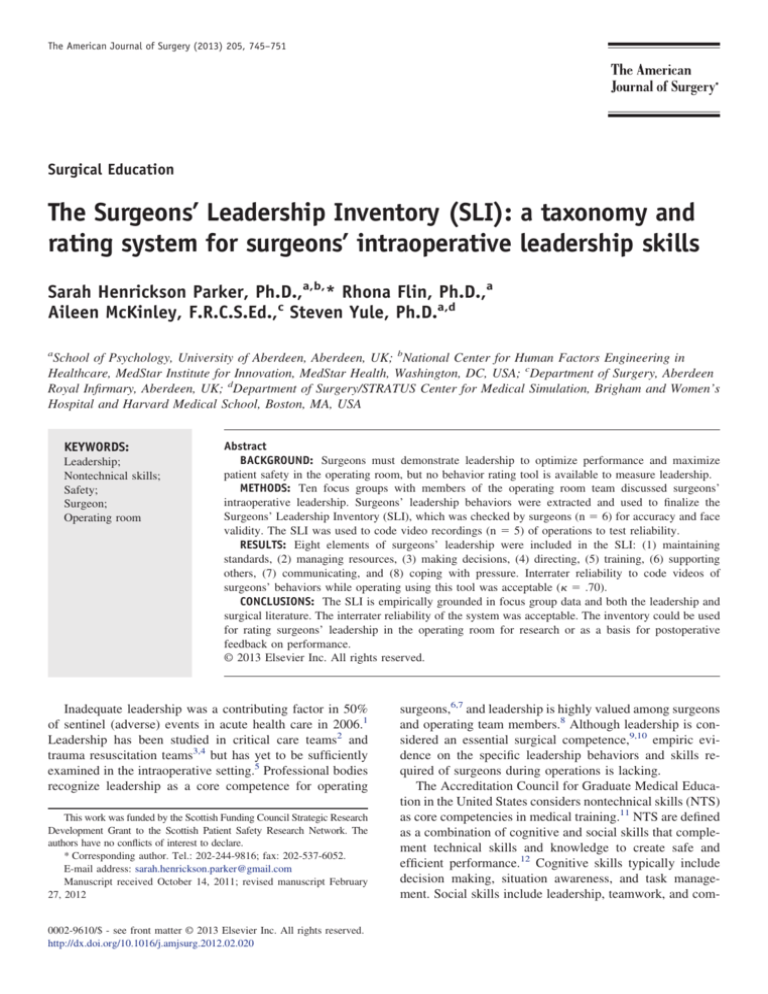
The American Journal of Surgery (2013) 205, 745–751
Surgical Education
The Surgeons’ Leadership Inventory (SLI): a taxonomy and
rating system for surgeons’ intraoperative leadership skills
Sarah Henrickson Parker, Ph.D.,a,b,* Rhona Flin, Ph.D.,a
Aileen McKinley, F.R.C.S.Ed.,c Steven Yule, Ph.D.a,d
a
School of Psychology, University of Aberdeen, Aberdeen, UK; bNational Center for Human Factors Engineering in
Healthcare, MedStar Institute for Innovation, MedStar Health, Washington, DC, USA; cDepartment of Surgery, Aberdeen
Royal Infirmary, Aberdeen, UK; dDepartment of Surgery/STRATUS Center for Medical Simulation, Brigham and Women’s
Hospital and Harvard Medical School, Boston, MA, USA
KEYWORDS:
Leadership;
Nontechnical skills;
Safety;
Surgeon;
Operating room
Abstract
BACKGROUND: Surgeons must demonstrate leadership to optimize performance and maximize
patient safety in the operating room, but no behavior rating tool is available to measure leadership.
METHODS: Ten focus groups with members of the operating room team discussed surgeons’
intraoperative leadership. Surgeons’ leadership behaviors were extracted and used to finalize the
Surgeons’ Leadership Inventory (SLI), which was checked by surgeons (n ⫽ 6) for accuracy and face
validity. The SLI was used to code video recordings (n ⫽ 5) of operations to test reliability.
RESULTS: Eight elements of surgeons’ leadership were included in the SLI: (1) maintaining
standards, (2) managing resources, (3) making decisions, (4) directing, (5) training, (6) supporting
others, (7) communicating, and (8) coping with pressure. Interrater reliability to code videos of
surgeons’ behaviors while operating using this tool was acceptable ( ⫽ .70).
CONCLUSIONS: The SLI is empirically grounded in focus group data and both the leadership and
surgical literature. The interrater reliability of the system was acceptable. The inventory could be used
for rating surgeons’ leadership in the operating room for research or as a basis for postoperative
feedback on performance.
© 2013 Elsevier Inc. All rights reserved.
Inadequate leadership was a contributing factor in 50%
of sentinel (adverse) events in acute health care in 2006.1
Leadership has been studied in critical care teams2 and
trauma resuscitation teams3,4 but has yet to be sufficiently
examined in the intraoperative setting.5 Professional bodies
recognize leadership as a core competence for operating
This work was funded by the Scottish Funding Council Strategic Research
Development Grant to the Scottish Patient Safety Research Network. The
authors have no conflicts of interest to declare.
* Corresponding author. Tel.: 202-244-9816; fax: 202-537-6052.
E-mail address: sarah.henrickson.parker@gmail.com
Manuscript received October 14, 2011; revised manuscript February
27, 2012
0002-9610/$ - see front matter © 2013 Elsevier Inc. All rights reserved.
http://dx.doi.org/10.1016/j.amjsurg.2012.02.020
surgeons,6,7 and leadership is highly valued among surgeons
and operating team members.8 Although leadership is considered an essential surgical competence,9,10 empiric evidence on the specific leadership behaviors and skills required of surgeons during operations is lacking.
The Accreditation Council for Graduate Medical Education in the United States considers nontechnical skills (NTS)
as core competencies in medical training.11 NTS are defined
as a combination of cognitive and social skills that complement technical skills and knowledge to create safe and
efficient performance.12 Cognitive skills typically include
decision making, situation awareness, and task management. Social skills include leadership, teamwork, and com-
746
The American Journal of Surgery, Vol 205, No 6, June 2013
Table 1
Focus group participant demographics
Discipline
Participant group
n per group
Experience level per group
Length (h:min:s)
Surgeon
1
2
3
1
2
1
2
3
1
2
3
9
4
14
4
8
4
3
4
11
3 to 7 y postconsultancy
1 to ⬎15 y postconsultancy
13 to 30 y postconsultancy
ST 1–6, SPR 4, 5
SPR 3–5
⬎5 y experience in theater
3 to 25 y experience in theater
3 to ⬎10 y experience in theater
13 to 32 y postconsultancy
2.5 to 15 y postconsultancy
01:08:51
00:45:25
00:51:32
01:04:07
00:58:22
00:44:11
00:47:45
00:31:50
01:07:05
00:49:41
Trainee
Nurse
Anesthetist
SpR ⫽ specialist registrar; ST ⫽ surgical trainee.
munication. Currently, NTS are not widely taught in health
care13 but can be trained through on-the-job methods, lectures about teamwork, or simulation-based training.14
To effectively evaluate NTS, rating tools must be developed with clearly defined, observable elements.15 A combination of task analysis methods such as observations,
interviews, or subject matter expert review can be used to
ensure that the NTS taxonomy is context specific and has
content validity. These methods clarify exemplar behaviors
to be associated with each element. Thus, the behaviors can
be observed and the skills rated by a trained assessor.
Taxonomies and related tools to train and evaluate NTS
have been developed in many industries, such as aviation,16
anesthesia,17 and surgery.18 Once developed, these systems
were subject to systematic experimental and practical evaluation, ensuring that the identified skills and associated
behaviors were observable and could be reliably identified
and rated. Of particular importance for applied researchers
is that the tools are usable within the work domain and have
face validity with practitioners.
Task analyses conducted to develop the Non-Technical
Skills for Surgeons taxonomy revealed that expert surgeons
believed leadership to be important for safety and efficiency
in the operating room (OR).18,19 Although Non-Technical
Skills for Surgeons and other intraoperative NTS rating
tools, such as the Oxford Non-Technical Skills20 and Revised Non-Technical Skills21 tools, have examined surgeons’ leadership as part of a larger skill set, these tools
define leadership in different ways and suggest different
component elements of leadership, and none is sufficiently
detailed for an in-depth analysis of surgical leadership. To
our knowledge, a sufficiently fine-grained taxonomy of surgeons’ leadership skills has not been developed, and consequently there is no evidence-based tool for identifying and
classifying surgeons’ intraoperative leadership behaviors.5
The aim of this study was to identify elements of surgeons’ intraoperative leadership and then finalize and test
the reliability of a prototype rating tool, the Surgeons’
Leadership Inventory (SLI). In this report, we describe 2
studies. Study 1 was a focus group study conducted with
surgeons, nurses, anesthetists, and trainee surgeons to iden-
tify surgeons’ leadership behaviors in the intraoperative
setting and resulted in a preliminary taxonomy, the SLI. In
study 2, the interrater reliability of this taxonomy was tested
using video recordings of live operations.
Study 1: focus group
Methods
This study was approved by the University of Aberdeen
School of Psychology and North of Scotland Research Ethics Committees.
Ten single-discipline focus groups were arranged (see
Table 1 for demographic information). There were no selection criteria for participation in the focus groups; participation was open to the entire OR team, and everyone who
volunteered to participate was included in the study.
Single-discipline groups were chosen to engage the maximum number of staff members, while minimizing possible
bias from interactions across disciplines, and to enable participants to enter the focus group sessions even if their entire
operating teams were not present or did not want to participate. Ideally, focus groups should include between 4 and 8
people.22 However, on 3 occasions, ⬎8 participants volunteered, and it was decided to include all participants who
showed an interest in taking part.
The purpose of the focus groups was to identify leadership behaviors of surgeons in the intraoperative setting.
Although the surgeon may not be the sole leader of the
surgical team, he or she retains responsibility for the outcome of the operation and is the de facto leader of the
intraoperative team. To achieve this goal, a question schedule was developed on the basis of the surgical and psychological literature on surgeons’ leadership.
The focus groups took place over 2 months (November
and December 2009) and were facilitated by 1 psychologist
(S.H.P.). All groups lasted between 30 minutes and 1 hour
and were audio recorded. After completion of all 10 focus
S.H. Parker et al.
The Surgeons’ Leadership Inventory
groups, the digital audio files were transcribed verbatim for
analysis.
Statements on surgeons’ leadership behaviors were extracted from all focus groups’ transcripts and were assigned
short summary codes intended to simplify the verbatim
content of the behaviors. The behaviors were assigned to a
preliminary taxonomy of surgeons’ intraoperative leadership, which had been developed on the basis of a review of
the literature5 and an observation study.23 Any behaviors
that did not fit into the preliminary taxonomy were listed
separately and were discussed by a group of subject matter
experts.
The development of the taxonomy was based on 3 essential stages.24 First, the target behavioral domain must be
clearly defined, which in this case was the leadership behaviors of surgeons in intraoperative teams. The second step
was to ensure that the observable outcomes were related to
the behaviors. The outcome of interest was patient safety
and team performance. Thus, all behaviors to be included in
this taxonomy were expected to influence patient safety and
team performance, although this relationship may not be
direct. Testing of this relationship was outside the scope of
this report, but according to expert review and the leadership literature, this relationship would be expected. The
third step was to ensure that the taxonomy was internally
and externally valid. Using the subject matter experts in
both surgery and industrial psychology, we provide an initial examination of the taxonomy’s validity. Additionally,
the reliability of using the taxonomy was tested in study 2.
Results
It was clear from this exercise that some behaviors mentioned by the focus groups revealed leadership behaviors
that had not been previously identified for surgeons, and
therefore the taxonomy was revised. See Table 2 for the
preliminary and final leadership taxonomies.
Definitions for each behavior were further clarified by
the 3 psychologists (S.H.P., S.Y., R.F.), and the revised
taxonomy and definitions were given to 6 subject matter
experts (consultant or attending surgeons) familiar with
NTS for review to establish face validity. Other surgical
Table 2
747
skills tests have used face validity as an initial estimate of
validity,25,26 and further testing of construct or criterionrelated validity is necessary to determine the validity of a
test.27 Minor wording changes to the definitions were integrated, but no major changes were suggested. The final
taxonomy, the SLI, is shown in Table 3.
Study 2: testing the taxonomy
Methods
To test the SLI for reliability, a series of videos of live
surgical operations were analyzed. The study was approved
by National Research Ethics Service of the National Health
Service and the University of Aberdeen School of Psychology ethical review board.
The SLI (Table 3) was used by 2 psychologists to independently code video recordings of live operations using
Studiocode version 2.5.49 (Studiocode Business Group,
Sydney, Australia). Coders were trained during two 2-hour
training sessions. The first centered on learning how to use
the software, and the second session focused on learning the
SLI definitions and behaviors included for each element.
To test interrater reliability, videos (n ⫽ 5) ranging from
55 minutes to 2 hours 30 minutes in length were coded,
showing each operation from patient entry into the OR until
placement of the last suture. Operations selected for analysis
included 2 right hemiarch replacements, 1 inguinal hernia
repair, 1 laparoscopic cholecystectomy, and 1 carotid endarterectomy.
Studiocode enabled the coders to watch each video in its
entirety but with the facility to pause, rewind, and review
any segment. A graphical representation of the elements in
the SLI was created and added to the program, which is
visible in Figure 1. The software provides a digital video, a
timeline, and a clickable graphic of each possible element in
the SLI (Fig. 1). Coders were able to categorize each leadership behavior by clicking on the element “button” in the
on-screen graphic. The behavior was coded and timestamped in the timeline. Coding of the 5 videos took place
Development of the SLI
Preliminary taxonomy*
Modification
SLI
Maintaining standards
Managing tasks
Making decisions
Managing resources
Directing and enabling
Guiding and supporting
No change
Behaviors included in “directing”
No change
No change
“Enabling” removed
Split into “training” and “supporting others”
Communicating and coordinating
“Coordinating” removed
Newly added: “coping with pressure”
Maintaining standards
—
Making decisions
Managing resources
Directing
Training
Supporting others
Communicating
Coping with pressure
*Identified in Henrickson Parker et al.5,23
748
Table 3
The American Journal of Surgery, Vol 205, No 6, June 2013
The SLI elements and definitions
Element
Definition
Maintaining standards
Supporting safety and quality by adhering to acceptable principles of surgery, following codes of good
clinical practice, and enforcing theater procedures and protocols by consistently demonstrating
appropriate behaviors (ie, asking for help when required).
Seeking out appropriate information and generating alternative possibilities or courses of action,
synthesizing the information, choosing a solution to a problem, and letting all relevant personnel
know the chosen option. Making an informed prompt judgment on the basis of information, clinical
situation, and risk and continually reviewing its suitability in light of changes in the patient’s
condition.
Assigning resources (people and equipment) depending on the situation or context; delegating tasks
appropriately to team members, and ensuring the team has what it needs to accomplish the task.
Clearly stating expectations regarding accomplishment of task goals; giving clear instructions; using
authority where required; demonstrating confidence in both leadership and technical ability.
Instructing and coaching team members according to goals of the task; modifying own behavior
according to team’s educational needs; identifying and maximizing educational opportunities.
Judging the capabilities of team members; offering assistance where appropriate; establishing a
rapport with team members and actively encouraging them to speak up.
Giving and receiving information in a timely manner to aid establishment of a shared understanding
among team members. Speaking appropriately for the situation. Asking for input from team
members.
Showing flexibility and changing plans if required to cope with changing circumstances to ensure that
goals are met; anticipating possible complications and communicating them to staff; adopting a
forceful manner if appropriate without undermining the role of other team members.
Making decisions
Managing resources
Directing
Training
Supporting others
Communicating
Coping with pressure
over 1 week, after which interrater reliability was calculated
using Cohen’s , with criteria of ⬎.6 as acceptable, ⬎.7 as
good, and ⬎.8 as excellent.28 The coefficient was chosen
for interrater reliability because it assesses the degree to
which different raters or observers give consistent estimates to the same phenomenon. For this study, it was
considered important that 2 different raters could identify
and code the same leadership behaviors at an acceptable
level of reliability.
Results
Interrater reliability using the SLI across the 4 videos
was ⫽ .70, which is considered good.28 Directing and
training behaviors were the most challenging to reliably
code and were most often interchanged by the 2 coders.
Comments
The SLI was designed to provide an evidence-based skill
set for training and to also allow structured observation and
assessment of surgeons’ leadership in the intraoperative
setting. The 8 elements were empirically developed through
an iterative process including a literature search, observations of surgeons’ leadership, and focus groups with different groups of clinical personnel. After minimal training, 2
coders were able to use the taxonomy to identify and categorize leadership behaviors in the videos of live operations
at an acceptably reliable level. This study has taken an
additional step beyond the available NTS taxonomies for
surgeons discussed above, by focusing on 1 particular category of skill in detail. The SLI is advantageous because it
has been iteratively developed using subject matter experts
in both psychology and surgery.
In industrial models of team leadership, goal setting and
clarification, as well as team maintenance behaviors, such as
developing a positive climate within the team, solving interpersonal problems, or developing group cohesion, are
important for effective leadership.29 However, from the
focus groups, surgeons do not seem to engage in team
maintenance behaviors, as would be expected according to
the leadership literature. This may be because the goal of the
task is discussed preoperatively or is implicit (to get the
patient through surgery safely) and therefore is not specifically discussed in the intraoperative phase. Or it could be
because the technical tasks of the operating team differ in
such a way that there is not a shared task that unites the team
other than to, again, get the patient through surgery safely.
Surgeons may not see it as part of their leadership role to
always ensure that the team is adequately cared for (“maintained”), because the team is often ad hoc, and the surgeon
is only in a team supervisory role for the intraoperative
phase of the operation, which is a relatively short period. In
the focus groups, surgeons stated that making sure the team
is “on board” and “present” were important but did not
discuss managing conflict or building commitment between
team members. Surgical teams who remain working together in small hospitals or in very specialized areas may
show different team maintenance behaviors.
Many other NTS were alluded to when gathering the data
to develop the leadership taxonomy, as may have been
S.H. Parker et al.
The Surgeons’ Leadership Inventory
Figure 1
749
Screenshot of the Studiocode interface.
expected given the interrelatedness of critical NTS in practice. For example, surgical decision making has been examined as an NTS itself,30 separate from leadership. However,
in this study, operating team members frequently discussed
the surgeon’s ability to make decisions as imperative to
effective intraoperative leadership. In their model of team
leadership, Hughes et al31 include decision making as an
integral team leadership function, essential for teams to
complete their task.
Because most NTS are observed through communication, it is difficult to determine if communication should be
classified as an independent NTS in and of itself. For example, in the Anaesthetists’ Non-Technical Skills framework, communication is not explicitly mentioned, but “exchanging information” is an element of teamwork.17
Similarly, in the Non-Technical Skills for Surgeons system,
communication is grouped with teamwork as a category.32
However, in this study, communication was viewed by the
focus groups as an element of leadership and was therefore
included as a discrete element. Most models of leadership
(for an overview, see Fleishman et al33), at both the team
and the executive levels, include the ability to communicate
with followers and influence them to accomplish a goal.
In phase 2 of the present study, the reliability of the SLI
was tested using video recordings of live operations. Although the overall interrater reliability of the taxonomy was
good, some elements were less reliably coded than others,
specifically directing and training. Within academic hospital
settings, the issue of training and directing becomes especially prominent, because consultant surgeons must balance
the need for high patient care standards with the need to
offer trainees opportunities for independent practice.34
These 2 elements could be more reliably identified in the
future if further distinction is made between them in coder
training. It is also possible that because all the videos were
recorded in a teaching hospital, training behaviors were
much more common than they would be in a nonteaching
hospital.
As is common in applied research, there are some limitations to this study, which we did our best to minimize.
Only staff members from large teaching hospitals were
included in this study, so the results may need to be further
tested in smaller hospitals and nonteaching hospitals. The 8
elements for surgeons’ intraoperative leadership would
probably remain the same, with the exception of training for
nonteaching hospitals. This also highlights the issue of the
750
generalizability of the results given the small sample size. In
an attempt to capture the views of a broad range of participants, surgeons from various disciplines and geographic
locations within Scotland, as well as nonsurgeons, were
included. However, the SLI needs to be tested and validated
in a number of settings, such as simulations of live operations or multiple types of surgery (eg, those disciplines that
were not included in the development phase), before we are
confident that it can be considered a globally applicable
model of surgeons’ intraoperative leadership.
Surgeons’ leadership could differ depending on the type
of operation, because there are different requirements depending on the clinical task. For example, during cardiac
surgery, the perfusion aspect of the case and larger team
might add an additional level of leadership requirements.
Future research should include a larger variety of disciplines
to account for this. Researcher bias could also have influenced the results, because the researcher was also the facilitator of the focus groups. However, because the focus
groups were based on a predetermined structure, this bias
was minimized as much as possible. An additional limitation is that only surgeons were recruited to do a final review
of the taxonomy, although it had been developed with
experts from different disciplines in the OR. Because surgeons’ leadership was the focus of the tool, it seemed
logical for the subject matter experts to be involved in the
final review. Future research could include other disciplines
in a review of the SLI to further refine the definitions of
each element. Also, reliability tests were conducted between
2 psychologists and did not include any clinical experts.
Because the interest of this study was nonclinical (ie, leadership), it was decided that clinical knowledge was not
deemed necessary to identify leadership behaviors for the
purposes of reliability testing. However, future studies
should test the reliability of the taxonomy using surgeons as
raters, because their clinical perspective may distinguish
their identification of leadership behaviors compared with
psychologists. It would be especially important to establish
this if the SLI were to be used for feedback by surgeons
after real cases in the OR. Finally, although the coefficient
for interrater reliability using the taxonomy to rate the
videos showed substantial agreement, it is expected that this
would improve further as raters receive more training in and
practice using the taxonomy.
Conclusions
We describe the task analytic methods for development,
and preliminary reliability testing, of the SLI. The SLI was
found to be reliable when coding videos of live operations.
The next phase of research should focus on the quality or
effectiveness of these behaviors within the OR. It is also
important to examine the usability and reliability of this
taxonomy with clinical experts. In the future, this taxonomy
could be used by appropriately trained observers for assess-
The American Journal of Surgery, Vol 205, No 6, June 2013
ing surgeons’ leadership in the intraoperative setting and as
a tool for developing leadership training programs in surgery.
References
1. Joint Commission on Accreditation of Healthcare Organizations. Update: sentinel event statistics. Jt Comm Perspect 2006;26:14 –5.
2. Kunzle B, Kolbe M, Grote G. Ensuring patient safety through effective
leadership behaviour: a literature review. Saf Sci 2010;48:1–17.
3. Klein KJ, Ziegert JC, Knight AP, et al. Dynamic delegation: shared,
hierarchical, and deindividualized leadership in extreme action teams.
Adm Sci Q 2006;51:590 – 621.
4. Xiao Y, Seagull FJ, Mackenzie CF, et al. Adaptive leadership in
trauma resuscitation teams: a grounded theory approach to video
analysis. Cog Technol Work 2004;6:158 – 64.
5. Henrickson Parker SE, Yule S, Flin R, et al. Towards a model of
surgeons’ leadership in the operating room. BMJ Qual Saf 2011;20:
570 –9.
6. Dickinson I, Watters D, Graham I, et al. Guide to the assessment of
competence and performance in practising surgeons. ANZ J Surg
2009;79:198 –204.
7. University of Toronto. CanMEDS framework. Available at: http://
www.deptmedicine.utoronto.ca/CanMEDS.htm. Accessed: July 30,
2012.
8. American College of Surgeons. Frequently asked questions about surgical
residency 2001. Available at: http://www.facs.org/medicalstudents/
answer6.html. Accessed May 21, 2009.
9. Giddings A, Williamson C. The leadership and management of surgical teams. London: Royal College of Surgeons of England; 2007.
10. Krummel TM, Salzberg AD, Williams DB, et al. Accountability in
surgery. In: Manuel BM, Nora PF, eds. American College of Surgeons
surgical patient safety: essential information for surgeons in today’s
environment. Chicago: American College of Surgeons; 2004.
11. Accreditation Council for Graduate Medical Education. Program director guide to the common program requirements. Chicago: Accreditation Council for Graduate Medical Education; 2008.
12. Flin R, O’Conner P, Crichton M. Safety at the sharp end. Hampshire,
UK: Ashgate; 2008.
13. Flin R, Patey R. Improving patient safety through training in nontechnical skills. BMJ 2009;339:3595.
14. Rosen MA, Feldman M, Salas E, et al. Challenges and opportunities
for applying human factors methods to the development of nontechnical skills in healthcare education. In: Duffy VG, ed. Advances in
human factors and ergonomics in healthcare. London: CRC Press;
2011:1–10.
15. Klampfer B, Flin R, Helmreich RL, et al. Enhancing performance in
high risk environments: recommendations for the use of behavioural
markers. Available at: http://homepage.psy.utexas.edu/homepage/group/
helmreichlab/Publications/pubfiles/Pub262.pdf. Accessed July 21, 2012.
16. Flin R, Martin L, Goeters K, et al. Development of the NOTECHS
(Non-Technical Skills) system for rating pilots’ CRM skills. Hum
Factors Aerospace Saf 2003;3:95–117.
17. Fletcher G, Flin R, McGeorge M, et al. Anaesthetists’ Non-Technical
Skills (ANTS): evaluation of a behavioural marker system. Br J
Anesth 2003;90:580 – 8.
18. Yule S, Flin R, Maran N, et al. Surgeons’ non-technical skills in the
operating room: reliability testing of the NOTSS behavior rating system. World J Surg 2008;32:548 –56.
19. Yule S, Flin R, Paterson-Brown S, et al. Non-technical skills for
surgeons in the operating room: a review of the literature. Surgery
2006;139:140 –9.
20. Mishra A, Catchpole K, McCulloch P. The Oxford NOTECHS system:
reliability and validity of a tool for measuring teamwork behaviour in
the operating theatre. BMJ Qual Saf 2009;18:104 – 8.
S.H. Parker et al.
The Surgeons’ Leadership Inventory
21. Sevdalis N, Davis R, Koutantji M, et al. Reliability of a revised
NOTECHS scale for use in surgical teams. Am J Surg 2008;196:
184 –90.
22. Kitzinger J. Qualitative research: introducing focus groups. BMJ 1995;
311:299.
23. Henrickson Parker SE, Yule S, Flin R, et al. Surgeons’ leadership in the
operating room: an observational study. Am J Surg 2012;204:347–54.
24. Fleishman EA, Quaintance MK. Taxonomies of human performance:
the description of human tasks. Orlando, FL: Academic Press; 1984.
25. Fried GM, Feldman LS, Vassiliou MC, et al. Proving the value of
simulation in laparoscopic surgery. Ann Surg 2004;240:518 –28.
26. Moorthy K, Munz Y, Sarker SK, et al. Objective assessment of
technical skills in surgery. BMJ 2003;327:1032–7.
27. Korndorfeer JR, Kasten SJ, Downing SM. A call for the utilization of
consensus standards in the surgical education literature. Am J Surg
2010;199:99 –104.
28. Landis JR, Koch GG. The measurement of observer agreement for
categorical data. Biometrics 1977;33:159 –74.
751
29. Kozlowski SWJ, Gully SM, Salas E, et al. Team leadership and
development: theory, principles, and guidelines for training leaders
and teams. In: Beyerlein M, ed. Advances in interdisciplinary studies
of work teams: team leadership, vol 3. New York: Elsevier Science/
JAI Press; 1996:253–91.
30. Pauley K, Flin R, Yule S, et al. Surgeons’ intraoperative decision
making and risk management. Am J Surg 2011;202:375– 81.
31. Hughes R, Ginnett R, Curphey G. Leadership: enhancing the lessons
of experience. Homewood, IL: Irwin; 1993.
32. Yule S, Flin R, Paterson-Brown S, et al. Development of a rating
system for surgeons’ non-technical skills. Med Educ 2006;40:1098 –
104.
33. Fleishman EA, Mumford MD, Zaccaro SJ, et al. Taxonomic efforts in
the description of leader behavior: a synthesis and functional interpretation. Leadership Q 1991;2:245– 87.
34. Moulton C, Regehr G, Lingard L, et al. Operating from the other side
of the table: control dynamics and the surgeon educator. J Am Coll
Surg 2010;210:79 – 86.

